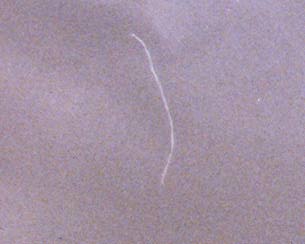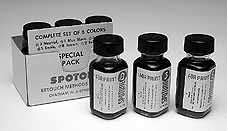

SPOTONE is probably one of the most frequently used spotting mediums in monochrome photography, and is supplied in six different colors that enable any black and white print to be satisfactorily retouched. For a number of years I have also used Spotone to retouch my color prints.
Using the neutral grey, selenium and blue black colours I can usually retouch most blemishes on a color print. Neutral grey will cover most small blemishes but if an area of blue sky needs retouching I add blue black. Should the area to be retouched be in the red /brown scale I add selenium. Only when the blemish is quite large in area do I need to introduce a color spotting medium.


Keep a container of clean water handy to clean the brush regularly so as to prevent too much spotting medium from building up on it. Should you apply too much medium to an area Spotone can be removed with an application of ammonia, but be sure to allow the print to dry fully before you carry on retouching. Ammonia is a poison so be careful to store it away from children.